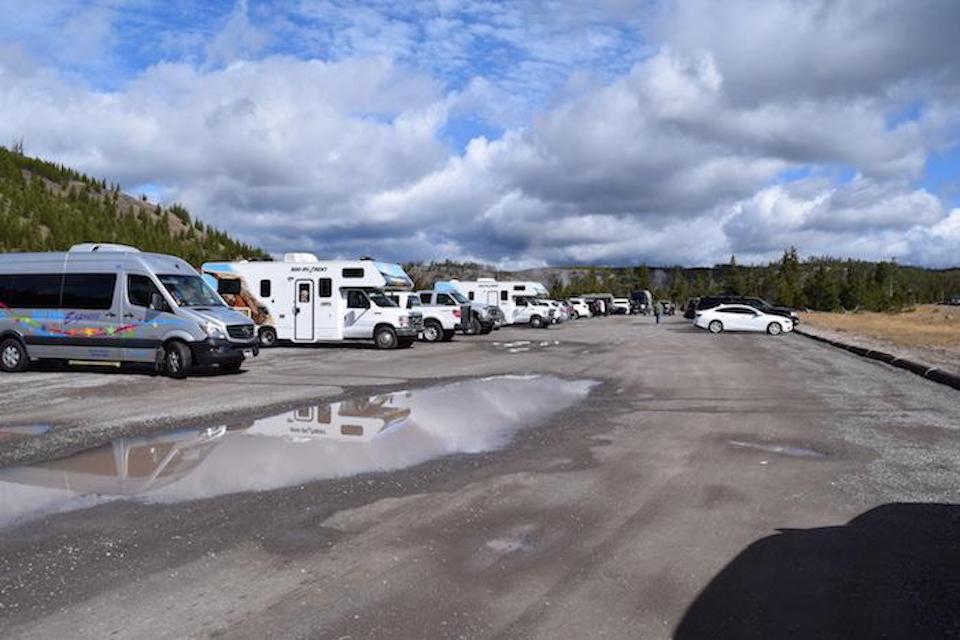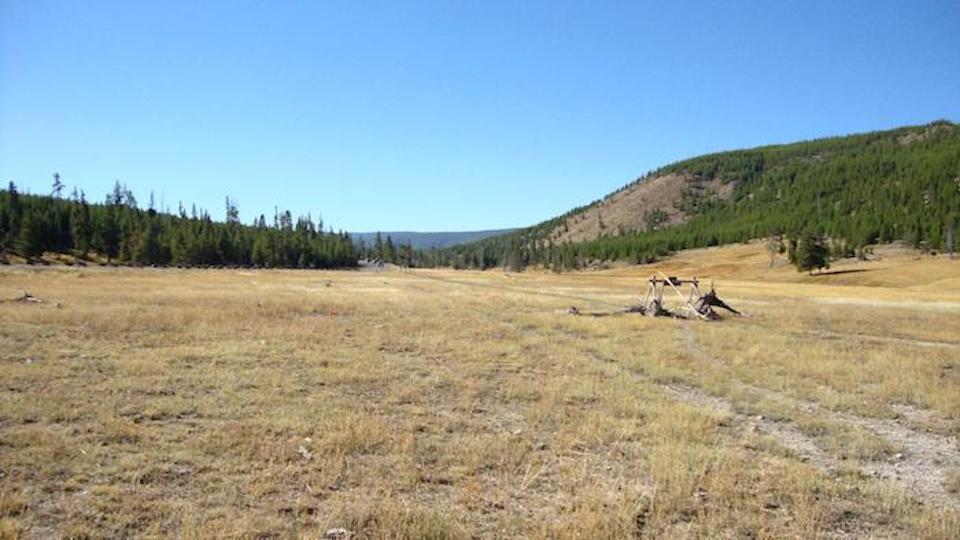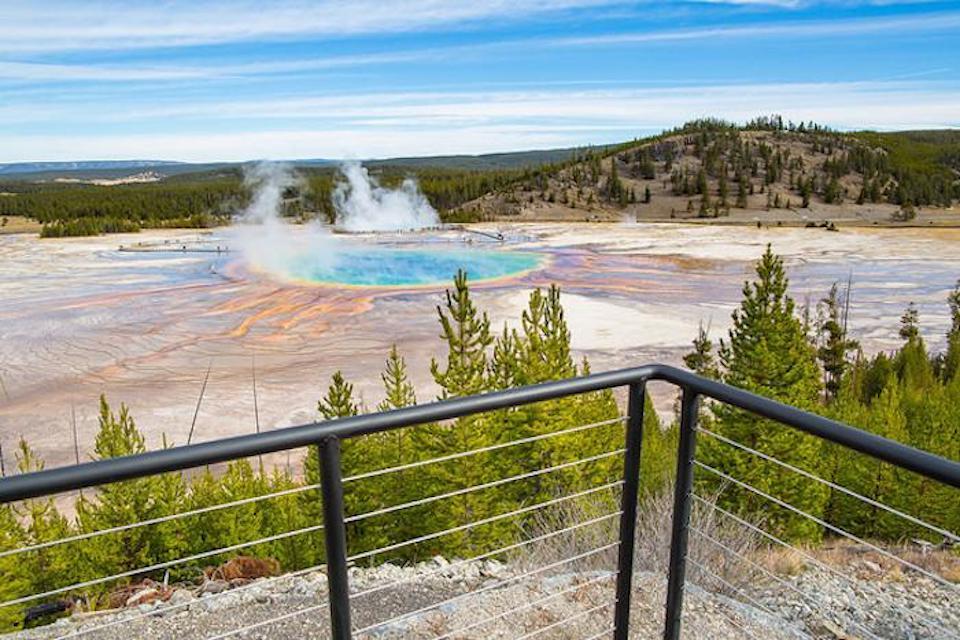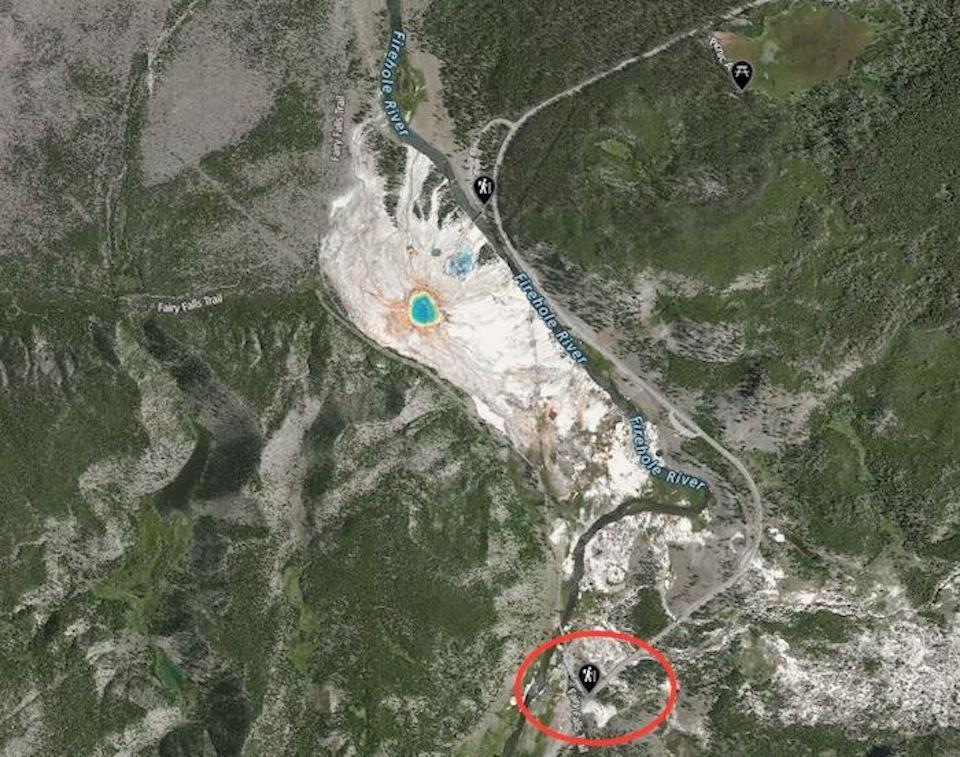
This temporary parking lot near the Fairy Falls Trailhead in Yellowstone will be removed this fall/NPT file
Altering human behavior is proving harder than providing for humans, at least in the case of a temporary parking area created near the Fairy Falls Trailhead in Yellowstone National Park. And because of that, the parking lot will be removed this fall.
"While the lot has alleviated some traffic congestion, it has not substantially improved traffic flows within the area as originally envisioned," said Yellowstone Superintendent Cam Sholly in an email. "Our data shows that social trailing is actually worse in some areas than previous to the parking lot being installed. And without proper supporting infrastructure, like restrooms and trash cans, litter and human waste have been very prevalent in the area."
Even if the park wanted to install restrooms at the parking area, it couldn't because of the geothermal resources in the area, the superintendent said.
Yellowstone officials back in 2016 broached the idea of building the lot on land once traversed by an old stage road. It was needed, they said at the time, because once the existing 55-spot parking lot at Grand Prismatic Spring filled up, visitors would park on the Loop Road that passed the popular spring. Some even parked in the middle of the road, according to park staff.

This ground near the Fairy Falls Trailhead was turned into the temporary parking area in 2017/NPS file
Ideally, rangers would have been positioned there to manage traffic, but the park didn't have enough personnel to take that approach.
So in 2017 a three-quarters-of-an-acre gravel lot was created near the Fairy Falls Trailhead. While the lot, which could handle about 70 vehicles, was intended for use by only passenger vehicles, buses and RVs frequently used it despite signs that said the lot was off-limit to buses, RVs, and vehicles with trailers.
At the time, a planning document distributed for public comment stated that, "the park would implement monitoring protocols to collect data on transportation capacity, visitor behavior/crowding, and resource impacts, both before and after the opening of the trailhead and parking area. This data would be compared to previous years' data and will assist the park in determining the effectiveness of this parking area and whether more analysis should be done to formalize this into a permanent parking area. If the parking area is not an effective solution to meet the purpose and needs of this project, the park would return the affected area to a natural condition."
The Fairy Falls Trail leads to both Fairy Falls and Imperial Geyser; another major draw, though, is a hill along the route that offers a bird’s-eye view of the nearby Grand Prismatic Spring in Midway Geyser Basin. Social media and guidebooks started driving so many people to this location that Yellowstone crews constructed an official trail and overlook to replace the many existing social trails on the hill.

The fate of this hardened overlook built in conjunction with the temporary parking lot remains to be determined/NPS file
That trail gradually climbs 105 feet over 0.6 miles from the Fairy Falls Trailhead to an overlook with views of Midway Geyser Basin. At the time, then-Superintendent Dan Wenk said the trail and overlook “provide a different view of Grand Prismatic Spring and minimize the growth of unsightly, unofficial social trails in the process.”
The public, however, apparently didn't fully embrace that plan, and some visitors seemed to gain a sense of entitlement and go where they shouldn't.
"The parking lot has encouraged visitors to get closer to thermal features than previously," Sholly said this week. "While no major resource damage has been documented, that risk exists if the parking lot continues to exist in future years."
A rehabilitation plan to erase the parking area is being developed and will be implemented this fall.
"We will initiate more formal efforts to look at the corridor and determine what options can be developed/evaluated to reduce traffic congestion and maximize the protection of geologic resources in the area," the superintendent said.
What happens to the trail that leads to the overlook of Grand Prismatic Spring will be determined down the road, he said.

The red circle shows where the gravel lot is located/NPS



Comments
I've been to Zion, they do a wonderful job with non-diesel busses every 15 minutes. I agree that bus-only in Yellowstone is not viable but how about shuttles to areas of cramped parking. Higher fees: remember these parks are for everyone and should be available to the poor as well as the wealthy! Let's be a bit more democratic. Busses and RVs should be restricted from cramped parking areas and those vehicles should be directed to shuttle bus terminals. Formal trails to points of interest and tasteful fencing (wooden posts with rope spans) should be used to control foot traffic. My personal solution is never to visit in the high seasons! Go in September or October before the lodges close. Your visit will be a much better quality time!
Please sober up.
A $1,000 PER YEAR entry fee to get into OUR National Parks is outrageous, and should be illegal. Management, not stupidity.
If you can afford it, make your contribution to OUR National Parks by paying the fee to drive your RV or vehicle in. If you can't afford it, just ride the shuttle bus in. It's long past time for us to embrace not just our personal freedom, but also our personal responsibility. It's time to step up and, if need be, remodel our selfish minds.
From my experience at Yellowstone, the problems were the number of buses that descended upon an area at one time and unloaded a massive amount of people who had limited time to be there. Many of whom rudely their way to whereever they were interested in going. I did find that the visitors who parked and traveled in private cars to be mostly courteous and respectful of the park. Limiting the number of people per day is certainly one answer, but I must agree with Sarah and others, that Yellowstone is not like other parks, and is so expansive, that to do what others suggest (buses) detracts from this most unique of experiences.